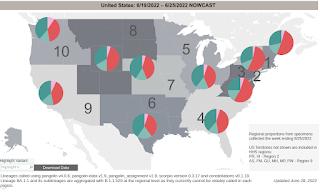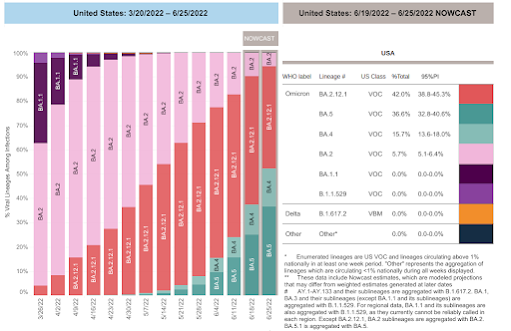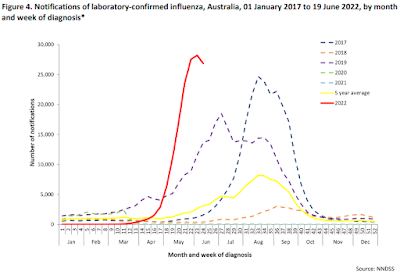Monkeypox Virus - Credit CDC PHIL
Three weeks ago the CDC - while admitting there were still some unknowns - adjusted their guidance on the transmission of Monkeypox (see CDC Statement On Monkeypox Transmission), relaxing some of their their recommendations on isolation and hospital infection control procedures.
This new guidance now only called for a private room (no special air handling required) and de-emphasized the potential airborne spread of Monkeypox. They provided some examples of how Monkeypox can and can't spread:
- No: Casual conversations. Walking by someone with monkeypox in a grocery store. Touching items like doorknobs.
- Yes: Direct skin-skin contact with rash lesions. Sexual/intimate contact. Kissing while a person is infected.
- Yes: Living in a house and sharing a bed with someone. Sharing towels or unwashed clothing.
- Yes: Respiratory secretions through face-to-face interactions (the type that mainly happen when living with someone or caring for someone who has monkeypox).
- Maybe/Still learning: Contact with semen or vaginal fluids.
- Unknown/Still learning: Contact with people who are infected with monkeypox but have no symptoms (We think people with symptoms are most likely associated with spread, but some people may have very mild illness and not know they are infected).
In fact, their example (above) specifically rules out transmission by touching objects like doorknobs.
Among the most contaminated surfaces they found were door knobs, cabinet door handles, faucets, and light switches.
How likely that is to occur, and whether additional infection controls are needed, isn't known yet. But we have a history of underestimating the ability of viruses to get around.
Evidence of surface contamination in hospital rooms occupied by patients infected with monkeypox, Germany, June 2022Dominik Nörz*,1 , Susanne Pfefferle*,1,2 , Thomas Brehm3,4 , Gefion Franke5 , Ilka Grewe3 , Birte Knobling5 , Martin Aepfelbacher1 , Samuel Huber3 , Eva M. Klupp5 , Sabine Jordan3 , Marylyn M. Addo4,6,7 , Julian Schulze zur Wiesch3,4 , Stefan Schmiedel3 , Marc Lütgehetmann1,4 , Johannes K. Knobloch4,5
Since 4 May 2022, the largest west-African-clade-monkeypox outbreak to date in countries with non-endemic occurrences has been described [1]. The outbreak involves transmission among people in close physical contact with symptomatic cases [1,2], in contrast to previous outbreaks, where zoonotic transmission was reported as the main mechanism of spread [3]. Nevertheless, events of person-to-person transmission have been previously described [3,4]. Additionally, transmission to personnel taking care of patients was reported on rare occasions [5,6]. Indirect transmission via contaminated objects is also discussed in the literature [6,7]. However, there are insufficient data on the environmental contamination of surfaces with monkeypox virus. We systematically examined surfaces of two hospital rooms occupied by monkeypox patients and the adjacent anterooms, which are used for donning and doffing personal protective equipment (PPE), for monkeypox virus contamination using PCR. In addition, we assessed the infectivity on cell culture of the collected samples by virus isolation.
(SNIP)
Discussion
Besides zoonotic transmission, monkeypox virus infections have been reported after person-to-person transmission [3]. To our knowledge, the highest rate of secondary cases described to date was in a central African outbreak in 1996–1997, where 65 (73%) of 89 case-patients with available data had had contact to another case-patient within 7–21 days before their onset of illness [4]. Person-to-person transmission with nosocomial transmission from a patient to three healthcare workers was reported in another African outbreak [5]. One nurse who evaluated the patient, and who later became ill, had removed the patient’s clothing, taken the patient’s temperature, and drawn blood without adequate PPE. Nosocomial transmission was also reported related to an imported case from Nigeria to the United Kingdom [6]. In this case, the infected healthcare worker changed potentially contaminated bed linen without adequate PPE.
There are no definite data on the required infectious dose with monkeypox virus in humans. However, in contrast to variola virus [9], a significantly higher dose is assumed to be required to trigger infection [10]. In non-human primates, infection could be initiated by intrabronchial application of 5×104 plaque-forming units (PFU) [11]. Orthopoxviruses are reported to remain infectious under dry conditions and different temperatures [12]. Dried vaccinia virus is stable up to 35 weeks (at 4 °C) without loss of infectivity [12]. In this study monkeypox virus was successfully isolated from three different samples, each with a total of at least 106 virus copies. Thus, contaminated surfaces with such viral loads or higher, could potentially be infectious and it cannot be ruled out that their contact with especially damaged skin or mucous membranes, could result in transmission.
Detection of up to 1.1×106 viral copies on gloves is consistent with the detection of viral DNA on surfaces typically handled only by medical staff such as the door handles of the anteroom. The detection of the virus at very low concentrations even outside the isolation unit indicates that containment protocols may not have been fully adhered to.
The findings in this report are subject to some limitations. As DNA is an environmentally stable molecule, detection of viral DNA by PCR cannot be equated with infectious virus. Despite high contamination with up to 105 cp/cm2 as well as the successful recovery of monkeypox virus from samples with a total of > 106 copies, our findings do not prove that infection can occur from contact with these surfaces. No secondary case in the context of clinical care of the two patients in our study has been observed so far. The study was performed only for two cases and might not be generalised to other cases. In particular, in certain cases, depending on the skin regions mainly affected and the number of lesions, the levels of contamination of different surfaces may vary.
Overall, these data underscore the importance to remind hospital personnel of the need to follow recommended protection measures for monkeypox. Sufficient time and attention must be given to the careful doffing of PPE and personnel must be properly trained in these procedures. Regular disinfection of frequent hand and skin contact points during the care processes additional to regular room cleaning and surface disinfection using products with at least virucidal activity against enveloped viruses can reduce infectious virus on surfaces and thereby risk of nosocomial transmission [13].
Suitable strategies for preventing the spread of the virus outside the patient's room must be individually adapted to the situation of the respective medical facility. The application of the double-gloving method [14] with discarding of the outer glove layer or disinfection of the gloved hand [15,16] before entering an anteroom can contribute to this. After the final doffing of the PPE, proper hand hygiene must be performed immediately. Pre-exposure vaccination for healthcare workers [17,18] as well as early post-exposure vaccination in the case of probable or confirmed contamination in the absence of or incorrectly applied protective equipment [18,19] may be considered.
Those living in the same households of affected individuals should be advised that, in addition to avoiding close physical contact, disinfection of shared skin- and hand-contact surfaces might be useful to prevent transmission [20,21]. At the present time, the viral load on inanimate surfaces required for disease transmission is unknown. Therefore, future studies should also investigate the dose dependent infectivity of such surfaces.














